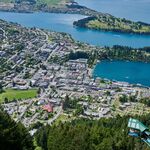YEG imagineer
Active Member
First time I've seen a teenager with a unicycle. He was motoring down the sidewalk beside 51st Ave. We need more bike lanes to attract more unicyclists.

The cycling lobby is trafficking in concern trolling. 132 Avenue could very well meet the traffic flow stats that support constructing a bike lane there and it's consistent with the initiative to invest in rejuvenating established neighborhoods. However, if a task force is allocated $100M to spend they're going to find ways to do it and the street pictured above (not sure what the address is) is a good example of wasteful spending. The probably of a cycling accident on that street is about the same as the probably of a home owner crossing the street to get to their car. It's a very low probability so there wasn't really a need for that bike path. If cyclists main concern is safety as they continually state, then why not use back alleys for bike lanes. There a numerous back alleys in established neighborhoods that have little to no traffic, home owners don't lose the parking in front on their houses, communities get upgraded, and the cost of a bike path is reduced because curbs and gutter aren't necessary in a back ally. A win win for everybody.The roadway in front of schools creates more hazards. This is just an example of concern trolling.
Spoken like someone that’s never biked through a back alley.The cycling lobby is trafficking in concern trolling. 132 Avenue could very well meet the traffic flow stats that support constructing a bike lane there and it's consistent with the initiative to invest in rejuvenating established neighborhoods. However, if a task force is allocated $100M to spend they're going to find ways to do it and the street pictured above (not sure what the address is) is a good example of wasteful spending. The probably of a cycling accident on that street is about the same as the probably of a home owner crossing the street to get to their car. It's a very low probability so there wasn't really a need for that bike path. If cyclists main concern is safety as they continually state, then why not use back alleys for bike lanes. There a numerous back alleys in established neighborhoods that have little to no traffic, home owners don't lose the parking in front on their houses, communities get upgraded, and the cost of a bike path is reduced because curbs and gutter aren't necessary in a back ally. A win win for everybody.
I've always said that driving, cycling and walking fairly regularly has turned me into a better and more aware driver and cyclist as it gives me a pretty wide range of different experiences & situations. It also makes me realize and appreciate just how dangerous driving really is, which I think is lost upon a lot of people.Well first of all, when a back alley hits a street, there's not a safe crossing there.
Look, we've all driven, parked, etc etc but it doesn't sound like you've ever biked anywhere or given any thought to the practical/safety considerations when trying to bike beyond just for purely recreational purposes.. Why don't you give it a try before you start preaching?
I suspect you have never tried to cycle a decent distance across the city? The idea of trying to use alley ways to commute 25 blocks is something. Why do you keep obsessing over 100mil over 5 years to build out a city wide network? That is peanuts compared to the huge amount spent on far less efficient car orientated infrastructure.The cycling lobby is trafficking in concern trolling. 132 Avenue could very well meet the traffic flow stats that support constructing a bike lane there and it's consistent with the initiative to invest in rejuvenating established neighborhoods. However, if a task force is allocated $100M to spend they're going to find ways to do it and the street pictured above (not sure what the address is) is a good example of wasteful spending. The probably of a cycling accident on that street is about the same as the probably of a home owner crossing the street to get to their car. It's a very low probability so there wasn't really a need for that bike path. If cyclists main concern is safety as they continually state, then why not use back alleys for bike lanes. There a numerous back alleys in established neighborhoods that have little to no traffic, home owners don't lose the parking in front on their houses, communities get upgraded, and the cost of a bike path is reduced because curbs and gutter aren't necessary in a back ally. A win win for everybody.
It shouldn't come as a surprise that cyclists are satisfied with the funding model for their bike paths. Cyclists on average are not low income or fixed income people but instead are a self centered higher income group that has the ability to make a contribution to their preferred transportation but are too tight to do so. Perhaps a better transportation funding strategy would be to make transportation free to everybody and fund it from revenue collected from income taxes.I suspect you have never tried to cycle a decent distance across the city? The idea of trying to use alley ways to commute 25 blocks is something. Why do you keep obsessing over 100mil over 5 years to build out a city wide network? That is peanuts compared to the huge amount spent on far less efficient car orientated infrastructure.
Take a look at this view of a marvel of car dependent infrastructure in south Edmonton. A free flow overpass from Calgary Trail into South Edmonton Common. Built around 2008 I believe. If built today it would likely cost 100 mil+.
Calgary Trail Into S.E.C.
AAWDT data from the COE has 11000-13000 users on this lengthy overpass, about 7 to 9 users per minute. On the high end for a collector roadway. Does that warrant a grade separated interchange?
If I was a no spend conservative (as I suspect you may be), this project would catch my ire much more than a city wide bike network.
Cyclists come from all income groups, dude. And as has been thoroughly debated here, they already contribute to the funding by paying property taxes just like everybody else. And the argument that motor vehicle owners pay for the car infrastructure with their many fees doesn't really stand. The construction and maintenance of roads far exceeds the amounts collected by licensing and the gas tax, and insurance doesn't go to funding infrastructure, especially in Alberta, where we have private insurance providers.It shouldn't come as a surprise that cyclists are satisfied with the funding model for their bike paths. Cyclists on average are not low income or fixed income people but instead are a self centered higher income group that has the ability to make a contribution to their preferred transportation but are too tight to do so. Perhaps a better transportation funding strategy would be to make transportation free to everybody and fund it from revenue collected from income taxes.
And the tax paid by motorists at the pump? And the user fees paid by transit rides? None of that means anything to you? Let me add that the bicycles seen at the coffee shops are not from WalMart that the kids in the north east ride. Most of bike paths are catering to a demographic that ride thousand dollar plus bicycles to the coffee shop.Cyclists come from all income groups, dude. And as has been thoroughly debated here, they already contribute to the funding by paying property taxes just like everybody else. And the argument that motor vehicle owners pay for the car infrastructure with their many fees doesn't really stand. The construction and maintenance of roads far exceeds the amounts collected by licensing and the gas tax, and insurance doesn't go to funding infrastructure, especially in Alberta, where we have private insurance providers.
Just for the sake of argument, let's say Alberta has 5 million private vehicles circulating on the roads, with a licensing fee of $85/year, that's $425M dollars to build and maintain the whole car infrastructure of the province, which doesn't even come close to being enough. The rest is subsidized by everyone, be they vehicle owners or not. Just for the sake of argument, in the years of 2019-2020 the provincial government spent $4.4Bn in the highway network alone, for a licensing revenue of roughly $700M in licenses and $420M of the gas tax. That's about 25% of the total cost of highway maintenance and construction alone. And that's not counting city road maintenance, etc...So the remaining $3.3Bn, and the total expenditure of road maintenance in the cities, is a burden carried by every single private citizen and company in the province, by way of taxes (property taxes, income tax, GST, etc...).
So you're really telling me that the subsidized ones are the cyclists, because we're carving out $100M over several years for bike lanes, while the entire population is subsidizing literally BILLIONS every year for car infrastructure?
Give me a damn brea
The gas tax is literally addressed by the post you're quoting.And the tax paid by motorists at the pump? And the user fees paid by transit rides? None of that means anything to you?
Care to respond to any of the point I made in the original comment? Do you think that grade separated interchange access to South Edmonton Common is good use of public dollars?It shouldn't come as a surprise that cyclists are satisfied with the funding model for their bike paths. Cyclists on average are not low income or fixed income people but instead are a self centered higher income group that has the ability to make a contribution to their preferred transportation but are too tight to do so. Perhaps a better transportation funding strategy would be to make transportation free to everybody and fund it from revenue collected from income taxes.
Furthermore, the earlier tranches of funding dedicated to bike paths was used on some residential streets in places like Old Strathcona that did nothing to improve cycling safety. Most of those street are low traffic streets to begin with and bike paths were constructed to improve cyclists' cycling experience. Now cyclists like Constance want another $100M to take away the parking from more home owners so their cycling experience can improve?
I don't think this person is ever going to respond to a point we make. They're throwing stuff against the wall to see what sticks.Care to respond to any of the point I made in the original comment? Do you think that grade separated interchange access to South Edmonton Common is good use of public dollars?
If cyclists are high income people, that means they’re paying much higher property taxes and income taxes than others, right? As well as likely having a lower burden to the tax system with better health and less road damage caused by them?It shouldn't come as a surprise that cyclists are satisfied with the funding model for their bike paths. Cyclists on average are not low income or fixed income people but instead are a self centered higher income group that has the ability to make a contribution to their preferred transportation but are too tight to do so. Perhaps a better transportation funding strategy would be to make transportation free to everybody and fund it from revenue collected from income taxes.
Furthermore, the earlier tranches of funding dedicated to bike paths was used on some residential streets in places like Old Strathcona that did nothing to improve cycling safety. Most of those street are low traffic streets to begin with and bike paths were constructed to improve cyclists' cycling experience. Now cyclists like Constance want another $100M to take away the parking from more home owners so their cycling experience can improve?




